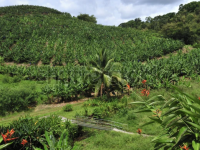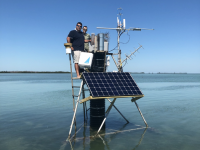C’est l’herbicide le plus utilisé au monde. C’est aussi un mot qui génère, dès qu’il est prononcé, d’intenses passions. Le glyphosate est utilisé en agriculture pour tuer les « mauvaises herbes », et ainsi limiter leurs effets négatifs sur les cultures. Ses effets sur l’homme et l’environnement restent eux sujets à débat dans la communauté scientifique.
Earth
A growing number of governments and companies are adopting net-zero greenhouse gas emissions targets. These targets often evoke nature as a way to store or remove carbon from the atmosphere to counter the climate effect of other emissions.
Though invasive weeds can devastate native plant communities, a recent study featured in the journal Invasive Plant Science and Management shows that efforts to manage those weeds can also cause harm.
A common suggestion is to restore natural CO2 reservoirs on the coasts that have been destroyed in many locations during the past decades. This includes mangrove forests, salt marshes and what are known as seagrass meadows. Seagrasses are aquatic plants that thrive in shallow, light-flooded water and are anchored by their roots to the soft seabed. For many animal species, such as manatees that live in tropical waters, seagrass meadows are vital grazing grounds. At the same time, they serve as nurseries all over the world for numerous young fish.
Pledges to cut greenhouse gas emissions are very welcome – but accurate monitoring across the globe is crucial if we are to meet targets and combat the devastating consequences of global warming.
During COP26 in Glasgow, many countries have set out their targets to reach net-zero by the middle of this century.
NEW YORK, NY (July 26, 2021)--Two types of drugs that are recommended as a first treatment for patients with high blood pressure were found equally effective in improving cardiovascular outcomes, but the more popular type causes slightly more side effects, finds a multinational observational study led by researchers at Columbia University Vagelos College of Physicians and Surgeons.
New research identifies cancer types with little survival improvements in adolescents and young adul
Survival rates for adolescents and young adults diagnosed with cancer have varied considerably depending on cancer type. A new study indicates that survival for multiple cancer types in such patients has improved in recent years, but some patients diagnosed with common cancer types still show limited survival improvements.
From the thrill of hearing an ice cream truck approaching to the spikes of pleasure while sipping a fine wine, the neurological messenger known as dopamine has been popularly described as the brain's "feel good" chemical related to reward and pleasure.
Research in mice, published today in Science Immunology by researchers at the Babraham Institute, UK and VIB-KU Leuven, Belgium, provides two solutions with potential to overcome a key clinical limitation of immune cell therapies. Regulatory T cells have potential in treating autoimmunity and inflammatory diseases yet they can switch from a protective to damaging function. By identifying the unstable regulatory T cells, and understanding how they can be purged from a cell population, the authors highlight a path forward for regulatory T cell transfer therapy.
Chemotherapy has helped make acute lymphoblastic leukemia (ALL) one of the most survivable childhood cancers. Now, researchers working in the U.S., Germany and China have shown how chemotherapy drugs called thiopurines can lead to mutations that set patients up for relapse. The work appears today in the journal Nature Cancer.
The research provides the first direct genomic and experimental evidence in pediatric cancer that drug-resistant mutations can be induced by chemotherapy and are not always present at diagnosis.
Rivers are lifelines for many countries. They create valuable ecosystems, provide drinking water for people and raw water for agriculture and industry. In the Global South in particular, there is strong competition for access to freshwater resources. The increasing use of hydropower has recently intensified this competition further.
Most children with a mental health disorder are not receiving services to address their needs--according to a new study from researchers at Simon Fraser University's Children's Health Policy Centre. Their research was published this week in the journal Evidence-Based Mental Health.
Researchers found that of the one in eight children (12.7 per cent) who experience a mental disorder, less than half (44.2 per cent) receive any services for these conditions.
The human body is essentially made up of trillions of living cells. It ages as its cells age, which happens when those cells eventually stop replicating and dividing. Scientists have long known that genes influence how cells age and how long humans live, but how that works exactly remains unclear. Findings from a new study led by researchers at Washington State University have solved a small piece of that puzzle, bringing scientists one step closer to solving the mystery of aging.
Almost all crop plants form associations with a particular type of fungi - called arbuscular mycorrhiza fungi - in the soil, which greatly expand their root surface area. This mutually beneficial interaction boosts the plant's ability to take up nutrients that are vital for growth.
The more nutrients plants obtain naturally, the less artificial fertilisers are needed. Understanding this natural process, as the first step towards potentially enhancing it, is an ongoing research challenge. Progress is likely to pay huge dividends for agricultural productivity.
About six gigatons -- roughly 12 times the mass of all living humans -- of carbon appears to be emitted over land every year, according to data from the Chinese Global Carbon Dioxide Monitoring Scientific Experimental Satellite (TanSat).
Using data on how carbon mixes with dry air collected from May 2017 to April 2018, researchers developed the first global carbon flux dataset and map. They published their results in Advances in Atmospheric Sciences.




